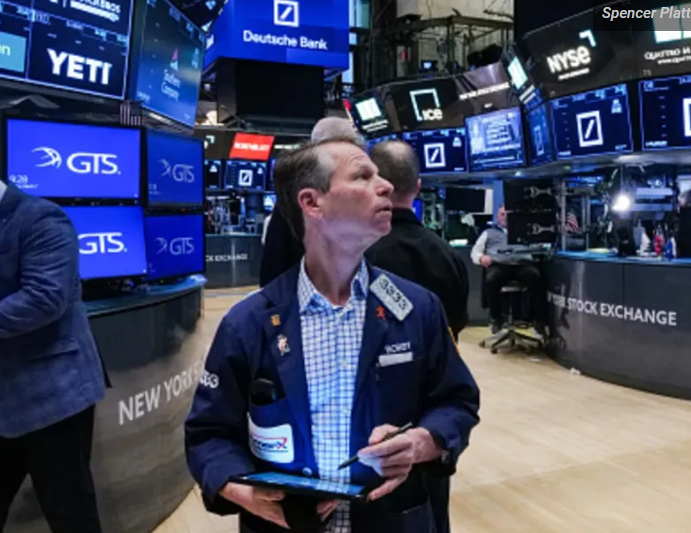Rocky U.S. Stock Market Faces Inflation Data Test
- quinnvaras
- Mar 9
- 3 min read

Market OverviewThe U.S. stock market faces another major test as a crucial inflation report approaches, with investors on edge about economic growth, Federal Reserve policy, and geopolitical uncertainties. Despite a modest rebound on Friday, the S&P 500 endured its worst weekly performance in six months. Meanwhile, the Nasdaq Composite, heavily weighted with technology stocks, entered correction territory after dropping more than 10% from its December peak.
Economic Concerns and Policy ShiftsMarkets remain volatile as investors navigate unpredictable policy changes. President Donald Trump's shifting stance on tariffs with Mexico, Canada, and China has amplified economic concerns. Additionally, Germany's unexpected fiscal policy shift rattled global markets, triggering a selloff in German Bunds.
Despite weakening U.S. economic data, one potential bright spot for stocks has been growing expectations for additional interest rate cuts by the Federal Reserve. However, these expectations could be overturned if Wednesday's Consumer Price Index (CPI) report signals persistently high inflation.
The Impact of Inflation on the Federal ReserveThe upcoming CPI report will be closely scrutinized, particularly after January’s higher-than-expected 0.5% rise, the largest monthly increase since August 2023. February’s CPI is anticipated to show a 0.3% increase, according to a Reuters poll.
The inflation report will be among the final key data points before the Federal Reserve meets on March 18-19. While the Fed is expected to keep its benchmark interest rate steady at 4.25%-4.5%, futures markets currently predict around 70 basis points of rate cuts by year-end. However, a stronger-than-expected CPI print could dampen these expectations.
"A hot CPI print will likely scare the market," noted Bryant VanCronkhite, senior portfolio manager at Allspring Global Investments. "The market still wants the Fed to come to the rescue... Until inflation and inflation expectations come down, the Fed is handcuffed."
Stagflation Concerns RiseInvestors are increasingly worried about the potential for "stagflation"—a combination of slowing economic growth and persistent inflation, which poses challenges for various asset classes. "An elevated CPI report could bring the 'S-word' into play," said John Velis, Americas macro strategist at BNY.
Recent employment data showed strong job growth in February, yet underlying cracks in the labor market suggest potential headwinds ahead, particularly given ongoing trade disputes and federal spending cuts.
Political and Trade Policy UncertaintyMarket participants are also focused on Washington, where lawmakers are negotiating a spending bill to avoid a partial government shutdown. The uncertain outlook on federal spending and tariffs remains a significant source of market volatility.
Trade policy, in particular, has taken center stage. Investors are assessing the impact of tariffs on corporate profits and consumer prices. Trump recently announced that Mexico and Canada would be temporarily exempt from certain tariffs until April 2, adding another layer of unpredictability to trade negotiations.
Market Volatility and Investor SentimentThe Cboe Volatility Index (VIX), a key measure of market risk, has surged to its highest levels since late last year. "Volatility is here to stay for a while because we do not have economic and trade policy certainty," said Irene Tunkel, chief U.S. equity strategist at BCA Research.
CoreWeave IPO: A New AI Powerhouse?Amid market turbulence, one notable upcoming IPO is CoreWeave, an Nvidia-backed cloud computing firm poised to play a significant role in the AI revolution. The company, which pivoted from cryptocurrency mining to AI infrastructure, has seen extraordinary growth, with revenue surging from $15.8 million in 2022 to $1.9 billion in 2024.
CoreWeave specializes in AI-optimized GPU clusters and boasts proprietary software innovations such as the SUNK platform and Tensorizer, which improve AI efficiency. Its rapid growth has drawn significant investor interest, with a potential IPO valuation of around $32 billion.
Potential Risks of CoreWeaveDespite its impressive growth, CoreWeave faces notable risks. The company is highly dependent on Nvidia’s hardware and Microsoft's cloud demand—62% of its 2024 revenue came from Microsoft. If Microsoft advances its own AI chip capabilities, CoreWeave’s reliance on third-party infrastructure could become a vulnerability.
Additionally, the broader AI market's future trajectory remains uncertain. While demand for Nvidia GPUs is robust today, the emergence of alternative AI hardware solutions from Amazon, Alphabet, and Microsoft could impact CoreWeave’s long-term competitive position.
ConclusionThe U.S. stock market is at a pivotal moment, with inflation data and Federal Reserve policy driving investor sentiment. While rate cuts remain on the table, persistent inflation could challenge the Fed’s flexibility, further unsettling markets. Meanwhile, trade tensions, government spending uncertainty, and upcoming IPOs like CoreWeave add additional complexity. Investors should brace for continued volatility as economic and policy uncertainties unfold in the weeks ahead.







Comments